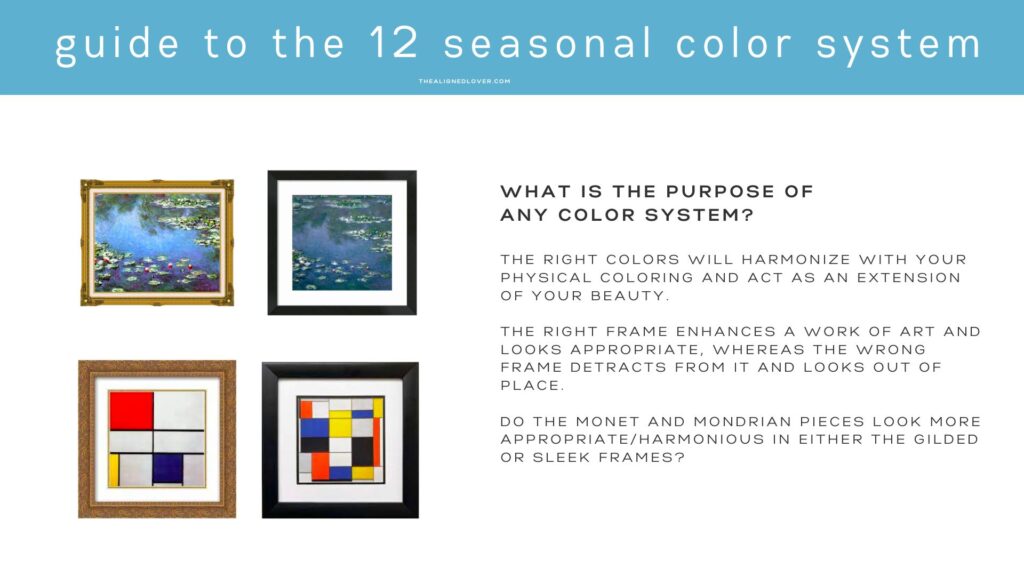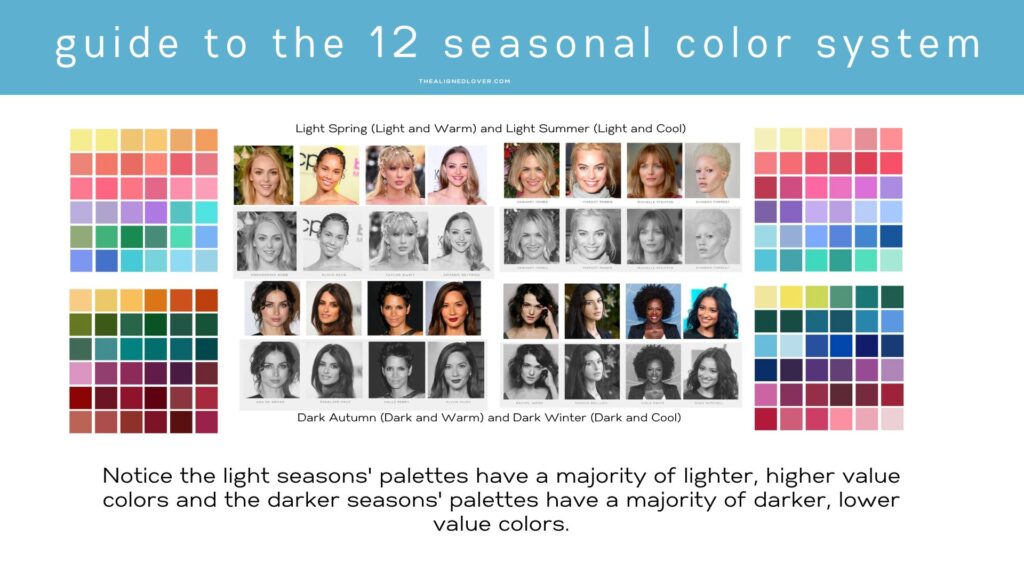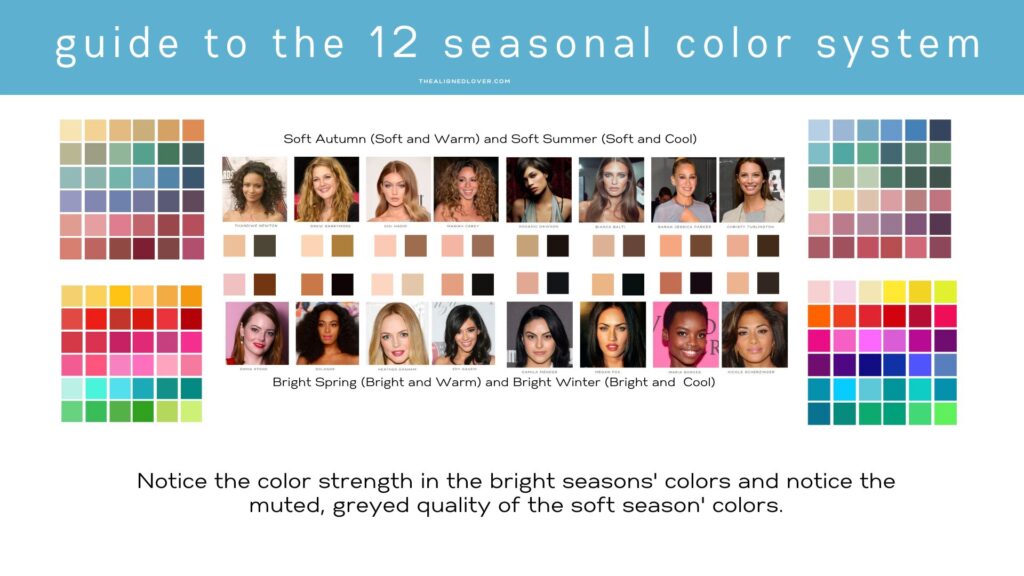Guide to the 12 Seasonal Color System: Pt. 2: Physical Color Dimensions and the 12 Seasons
In this post, I’ll elaborate on the color dimensions discussed in Part 1 of this color series, but first, let’s address the purpose of this entire endeavor.
What is the Purpose of Any Seasonal Color System?

The “best” colors are the ones that harmonize and enhance whatever subject they surround- whether it be a person, a painting, a room’s decor and furniture, or even a group of other colors. Colors that share similar hue temperature, value intensity, and chroma strength often look very harmonious together, as if they belong next to each other.
The “worst” colors do exactly the opposite- they detract from the subject or even create enough visual discord to cause color disharmony. If a color has ever made you look a bit sick or unwell or even forced into a false persona, that is color disharmony. Colors that lack similarity in terms of hue temperature, value intensity, or chroma strength often look awkward when grouped together.
Monet’s “Water Lillies” is enhanced by the antiquated golden frame as it harmonizes in terms of chroma (more muted overall), value (moderate to slightly dark/low), and hue temperature (on the warmer side overall…here is a fascinating article on the pigments Monet used). Even the frame’s intricate gilding acts as extension of the detailed florals, reflections, and ripples of the water. Oppositely, the cool stark black frame with the white background is very much at odds with the subject matter and looks very separate.
Mondrian’s geometric style and use of primary colors looks much more harmonious with an equally geometric and cleanly colored black and white frame. The art’s idea and message seems dismissed when it is surrounded by an ornate and textured, organic looking frame.
You are your own artwork, so you must do your due diligence in framing yourself in a harmonious way. Otherwise, you run the risk of feeling quite misunderstood and lacking the visual context to express yourself more clearly. The same dark black can make one person feel suffocated and the next person feel secure and confident. A bright yellow can make one person shine brighter whereas another recoils from its relative lack of restraint. A deep red can bring out the inherent sensuality of one person whereas it feels overly theatrical and heavy on the next. Color is very personal.
Warm vs Cool Dominant Seasons: True Spring, True Autumn, True Winter, and True Summer

Back to color dimensions. Let’s start off with hue temperature, which dominates the “True” seasons above. These are seasons that heavily focus on their color temperature and stay consistent throughout their palettes. These seasons do not veer into neutral territory- they are decidedly warm or cool.
Above are simplified color swatches of the skin and hair of these seasonal natives.
Notice the difference in skin tone and hair tone.
The warm seasons possess a strong apricot, peach, almond, and overall golden tone to their skin and a reddish, bronzed, or chestnut tone to their hair.
The cool seasons possess a strong beige, pink, blue-white, or cool cocoa tone to their skin with blue-black, silver, ash brown, and cool cocoa tones to their hair.
Also notice the secondary traits of each season. Though both dominantly warm, True Spring skin and hair is of higher chroma whereas True Autumn looks more muted. Autumn is also darker than Spring, so the values are not as light or high.
Though both are first and foremost cool, True Winter skin and hair is much more high contrast and brighter, whereas True Summer looks more muted and soft.

The same qualities seen in the general tones of the skin and hair are also seen in the seasonal palettes. Notice the dominance of warm hues (reds, oranges, yellows, and greens) in the True Spring and True Autumn palettes. Compare that to the dominance of blues, purples, and cool pinks in the True Winter and True Summer palettes. Even the hues that seem to be of the opposite temperature (i.e. yellows in cool seasons and blues in warm seasons) are still relatively warmer or cooler.
Light and Dark Dominated Seasons: Light Spring, Light Summer, Dark Autumn, and Dark Winter

To illustrate light and dark value ranges in physical coloring, I added a greyscale filter to leave out hues and isolate values and chroma.
Notice the light seasons- these natives have lower contrast and their colors stay within a lighter value range. For darker haired natives (like a possible Light Spring Alicia Keys), the most important aspect is the facial features, brows, and skin as well as draping. The darker seasons have more contrast and their dark values dominate.

Notice the range of values in the light seasonal palettes- they are predominantly lighter with little dark values. The dark seasonal palettes are mostly dark with very few lighter values. Also notice their respective secondary traits of hue temperature.
Soft and Bright Dominated Seasons: Soft Autumn, Soft Summer, Bright Spring, and Bright Winter

To illustrate chroma, I also took very simplified swatches of skin and hair. Notice how the skin and hair tones of the soft seasons are muted and touched by smokiness, whereas the bright seasons are very clear and crisp. The overall faced of the soft season natives are quite low in contrast and have an almost filtered look to them, whereas the features of the bright season natives tend to stick out more to create a more visually striking look.

The contrast in chroma is very apparent in the color palettes. Notice how hazy and diffuse the soft seasons’ palettes looks, especially when contrasted with the bright seasons’ very crystalline and intense palettes. Also notice the secondary characteristics of hue temperature.
The Transition Along the 12 Seasons

Starting from Bright Spring on the very left , watch how the palette lessens in chroma and deepens in warmth into True Spring. Next, the colors shift to very light values and gain a bit of coolness in Light Spring, and then transition into even more coolness in Light Summer. True Summer retains that coolness and a bit of lightness, but ultimately lessens in chroma. Chroma drops to the very lowest in cool Soft Summer, which also gains a bit of warmth. Even warmer and just as muted is the next season of Soft Autumn. Warmth prevails in muted True Autumn, with some darkness also making its presence. Darkness then dominates with Dark Autumn, a palette that leans into some coolness as well. Darkness and then coolness dominate in True Winter, which also gains in chroma. The chroma becomes very high, with predominantly cool colors mingling with slight warmth in Bright Winter.
Notice how there are no harsh boundaries between the seasons and that some neighboring palettes even seem to share colors.
The Nature of Palettes
Before you embark on your exploration of color, please note that these palettes and almost every palette you will find online are generalized. The palettes are not customized for a unique individual. Even if you find yourself resonating strongly with a certain season and palette, not all of the colors may look extremely harmonious on you and you may find that other seasonal palettes hold very fitting shades as well. What is most important is your exploration of color and your understanding of your own color needs. Also note that changes in hair color, skin color, and eyebrows can cause a marked difference in your overall color dimensions. Nothing is stagnant. Always allow for a range.
Seasonal Color FAQ
Q: What is the purpose of the 12 Seasonal Color System?
A: The system identifies colors that harmonize with your natural coloring—whether for wardrobe, makeup, or self-expression. Harmonious colors enhance your features, while disharmonious colors can feel awkward, harsh, or even make you look unwell. The goal is to create visual harmony that feels authentic to you.
Q: What are the main color dimensions in the 12 Season system?
A: There are three key color dimensions:
- Hue: the basic color family and temperature (warm vs. cool).
- Value: lightness or darkness of a color.
- Chroma: intensity or brightness of a color, ranging from muted to vivid.
Q: How do hue, value, and chroma affect seasonal color palettes?
A: Hue determines warmth or coolness, value sets lightness or darkness, and chroma affects clarity or mutedness. Together, these dimensions create the distinct qualities of each seasonal palette and help explain why some colors harmonize with your natural features more than others.
Q: What are True Seasons and how do they differ from Light, Dark, Soft, and Bright Seasons?
A: True Seasons (True Spring, True Summer, True Autumn, True Winter) have dominant traits in either warmth or coolness and maintain consistency throughout their palettes. Light, Dark, Soft, and Bright Seasons adjust secondary traits like value and chroma, creating lower or higher contrast and softer or more intense coloring.
Q: How do transitions work between the 12 seasons?
A: Neighboring seasons share certain color attributes, allowing smooth transitions. For example, Bright Spring gradually shifts into True Spring, then Light Spring, and so on. This continuum helps explain why some palettes have overlapping shades and why individual coloring may resonate with multiple seasonal palettes.
Q: Can seasonal palettes change with hair, skin, or eyebrow color?
A: Yes. Changes in your hair color, skin tone, or brow shade can affect which colors harmonize best. Seasonal color is not static—allow for a range and observe how different palettes interact with your unique features. For case studies, see my videos on skin and hair color changes:
Does A Tan Change Your Seasonal Color?
Does Changing Hair Color Change Your Season Pt. 1
Does Changing Hair Color Change Your Season Pt. 2
Q: Where can I learn more about applying the 12 Seasonal Color System?
A: My Virtual Guide to Navigating the World of Seasonal Color offers step-by-step instructions on understanding color dimensions and seasonal palettes. For more comprehensive, personalized guidance, the In-Depth Color Analysis service helps you integrate your seasonal color profile into your everyday style.
xx
Nona
